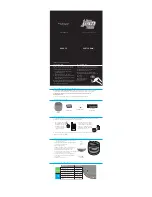
4
4
CONNECTIONS
CAUTION: Make sure that all of the system’s electrical components are turned OFF (and preferably
unplugged from their AC outlets) before making any connections.
Speakers and amplifiers have corresponding positive and negative (“+” and “–”) connection terminals. The 4367 has
two sets of connection terminals; jumper wires connect the terminals to each other. The terminals are marked “+” and
“–.” Additionally, the “+” terminals have red rings, while the “–” terminals have black rings. See the illustration below.
We have designed the 4367 so that a positive voltage at the “+” (red) terminal will cause the speaker transducers to
move outward (toward the room).
We recommend using a high-quality speaker wire with polarity coding. The side of the wire with a ridge or other coding
is usually considered positive polarity (“+”).
To ensure proper polarity, connect the left- and right-channel “+” terminals on the back of the amplifier or receiver to
their respective “+” (red) terminals on the speakers. Connect the “–” (black) terminals in a similar way. See the owner’s
manual of your receiver or amplifier to confirm its connection procedures.
BASIC SINGLE-WIRE CONNECTION:
Connect the amplifier to each speaker as shown in the illustration below. You can use either set of terminals on the speaker.
NOTE: Do not remove the jumper wires from between the two sets of terminals when connecting the speaker wires.
Receiver or Amplifier
Speaker
Connector Panel
IMPORTANT: Do not reverse polarities (i.e., “+” to “–” or “–” to “+”) when making connections. Doing so will cause poor
stereo imaging and diminished bass performance.
The 4367’s gold-plated speaker terminals can accept a variety of wire-connector types: bare wire, spade connectors,
pin connectors and banana connectors.
Using Bare Wire or Pin Connectors:
A. Unscrew Cap
B. Insert Bare Wire or
Pin Connector through
Hole in Post
C. Tighten Cap
to Secure Wire
IMPORTANT: Make sure the (+) and (–) wires or pins do not touch each other or the other terminal. Touching wires can
cause a short circuit that can damage your receiver or amplifier.


























